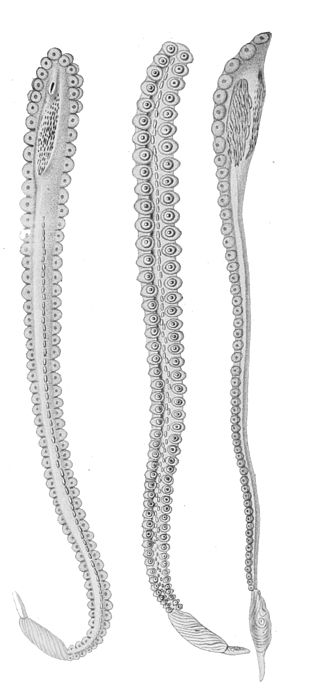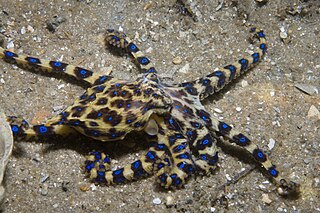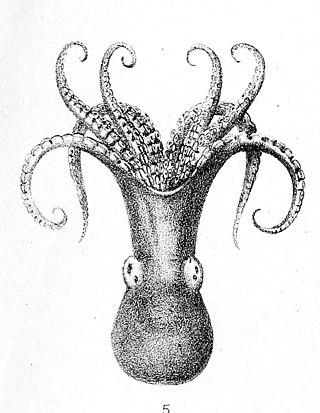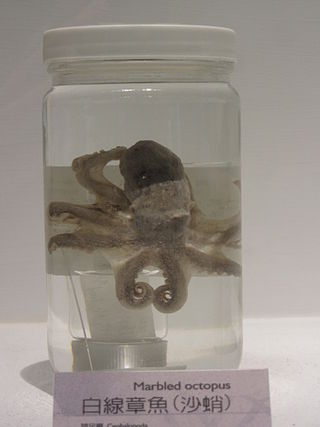
The Bolitaeninae are a subfamily, in the family Amphitretidae, of small, common pelagic octopuses found in all tropical and temperate oceans of the world. The taxonomy of this taxon is not entirely certain; recent research suggests just two genera exist, Bolitaena and Japetella, both of which are thought to be monotypic by some authorities and under this view, the family would represent two very similar species: Bolitaena pygmaea and Japetella diaphana. However, currently a second species of Bolitaena, B. massyae is also recognised.

Ocythoe tuberculata, also known as the tuberculate pelagic octopus or football octopus, is a pelagic octopus. It is the only known species in the family Ocythoidae.

Vitreledonella richardi, also known as the glass octopus, is an incirrate octopus. It is in the genus Vitreledonella and of the family Amphitretidae.

Opisthoteuthis californiana, also known as the flapjack octopus, or flapjack devilfish is a species of umbrella octopus.

A hectocotylus is one of the arms of male cephalopods that is specialized to store and transfer spermatophores to the female. Structurally, hectocotyli are muscular hydrostats. Depending on the species, the male may use it merely as a conduit to the female, analogously to a penis in other animals, or he may wrench it off and present it to the female.

The southern blue-ringed octopus is one of three highly venomous species of blue-ringed octopuses. It is most commonly found in tidal rock pools along the south coast of Australia. As an adult, it can grow up to 20 centimetres (8 in) long and on average weighs 26 grams (0.9 oz). They are normally a docile species, but they are highly venomous, possessing venom capable of killing humans. Their blue rings appear with greater intensity when they become aggravated or threatened.

The greater blue-ringed octopus is one of four species of extremely venomous blue-ringed octopuses belonging to the family Octopodidae. This particular species of blue-ringed octopus is known as one of the most toxic marine animals in the world.

Velodona togata is a species of octopus in the monotypic genus Velodona. First described by Carl Chun in 1915, with a second subspecies discovered by Guy Coburn Robson in 1924, it was named for the distinctive membranes on its arms.

Macroctopus maorum is known more commonly as the Maori octopus or the New Zealand octopus. It is found in the waters around New Zealand and southern Australia. M. maorum is one of the largest and most aggressive octopus species living in the New Zealand and Australian waters. They feed mainly on crustaceans and fish. Although they have a short life span, the females lay thousands of eggs and are very protective of them.

Illex coindetii, commonly known as the southern shortfin squid or broadtail shortfin squid, is a species of neritic squids in the family Ommastrephidae. They are found in the Mediterranean Sea and on both sides of the north Atlantic Ocean.
Eledone gaucha is a species of octopus from the southern Atlantic Ocean. It is a predator of fish, crabs, lobsters and molluscs.

Abdopus aculeatus is a small species of octopus in the order Octopoda. It has the common name algae octopus due to its typical resting camouflage, which resembles a gastropod shell overgrown with algae. It is small in size with a mantle around the size of a small orange and arms 25 cm in length, and is adept at mimicking its surroundings.

Macrotritopus is a poorly known genus of octopuses in the family Octopodidae. As it stands, Macrotritopus contains two valid described species, Macrotritopus defilippi from the NE Atlantic and Mediterranean, and Macrotritopus beatrixi from the Caribbean and SW Atlantic. Two poorly described, unresolved taxa are known only from planktonic hatchlings, and a further three undescribed Indo-Pacific species may be attributable to this genus.

Opisthoteuthis agassizii is a lesser-known, deep-sea octopus first described in 1883 by Addison E. Verrill.

Bathypolypus sponsalis, commonly called the globose octopus, is a deep sea cephalopod that can be found in both the eastern Atlantic Ocean and the Mediterranean Sea. It possesses many morphological traits adapted to a deep sea environment, including large eggs, reduced gills, no ink sac, and subgelatinous tissues. A distinguishing factor are the relatively large reproductive organs. Their diet consists of predominantly crustaceans and molluscs, but they sometimes consume fish as well. Bathypolypus sponsalis usually dies quickly after reproduction and only spawns once in their lifetime. Sexually mature females have a mantle length of at least 34 mm and sexually mature males have a mantle length of about 24 mm. Juveniles are white and transition to dark brown then to dark purple once maturity is reached.
Abdopus capricornicus is a species of octopus in the family Octopodidae, and is often also referred to as Octopus capricornicus. This octopus is native to the Great Barrier Reef and is often found throughout the Indo-West Pacific Ocean. There are six other species of octopuses within the subgenus Abdopus with a large number of organisms not yet described. This octopus is notable for its unique body patterning through which it can change. The likely uses for this characteristic are camouflage or intraspecific communication. Other organisms in the Abdopus genus include A. horridus, A. abaculus, A. aculeatus, and A. tonganus. Individuals are capable of autotomy, sacrificing a writhing arm to a predator to distract it while making an escape.

Octopus australis is a species of octopus. It gets the common name hammer octopus from a modified arm possessed by males and used in reproduction. It was first described by William Evans Hoyle in 1885, based on a specimen found in Port Jackson in New South Wales.

Octopus conispadiceus is a species of long-ligula octopus, provisionally placed in the genus Octopus. It was first described by Madoka Sasaki in 1917 based on specimens bought at a fish market in Sapporo, Japan.

Octopus superciliosus is a species of octopus. It was first described in 1832 by Jean René Constant Quoy and Joseph Paul Gaimard based on a specimen found off Victoria during the 1826 to 1829 voyage of the Astrolabe.

Amphioctopus aegina, commonly referred to as the marbled octopus or the sandbird octopus, is a bottom dwelling species residing in the coastal zone of the Indo-West Pacific. Planktonic hatchlings and eggs are laid by females predominantly during the months of January and October, however they have been known to reproduce year-round.


















